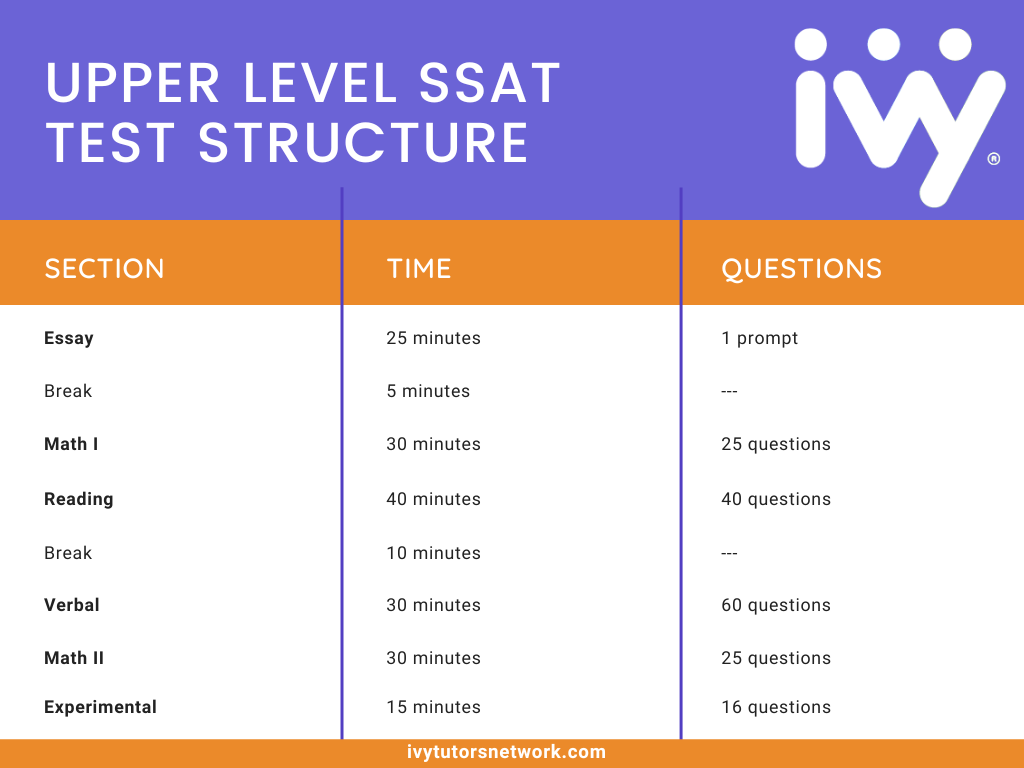
SSAT: Everything You Need to Know
The Secondary School Admission Test (SSAT) is a private school admissions test. It is administered at three levels: elementary, middle and upper. In this article, we'll tell you absolutely everything you need to know about the SSAT and how to study for it.

What is the SSAT?

The Secondary School Admission Test (SSAT) is a private school admissions test. It is administered at three levels: Elementary, Middle and Upper. The Elementary Level SSAT is designed for students who are currently in 3rd or 4th grade, the Middle Level SSAT for students in grades 5, 6, or 7, and the Upper Level SSAT for students in grades 8-11. It is offered in various formats – a paper test at a test center or school, a computerized test at a test center, or a computerized test at home – though the paper test is the most common form. The formats available to you will depend on your level and where you live.
What are SSAT test dates in the 2023-2024 school year?
The standard paper test is traditionally administered once a month from October to April. In the 2023-2024 school year, these dates are:
- October 14, 2023 (Upper and Middle)
- November 11, 2023 (Upper, Middle, Elementary)
- December 9, 2023 (Upper, Middle, Elementary)
- January 6, 2024 (Upper and Middle)
- February 3, 2024 (Upper and Middle)
- April 20, 2024 (Upper and Middle)
There are also additional paper testing dates, called Flex dates, which are administered by EMA-affiliated schools and consultants. Not all of the flex dates are open to the public, so availability may be limited. Computerized tests (at a test center or at home) are not restricted to the standard paper test dates.
Note that students are limited in the number of times they can sit the exam in a given school year. The limit depends on your level, where you live, and what format of the test you’re taking, so consult the official website for details.
How to register for the SSAT?
You need to register on the official website: ssat.org. You’ll need to make an online account, which you can use to register, apply for testing accommodations, to print your admission ticket, designate score recipients, reschedule your test, and receive score reports.
Keep in mind, that registering within two weeks of the test date will incur late fees. Also, applying for accommodations for students with disabilities closes 14 days before each test.
How much does the SSAT test cost?
The cost of the SSAT varies depending on your level, where you live, and what format of the test you take.
For students in the US taking the traditional paper test, the test costs $105 at the Elementary Level and $165 at the Middle/Upper Levels.
Students may be eligible for a fee waiver, which applies to the test fee only. Eligibility for a fee waiver is determined largely by household income.
SSAT Test Structure
The SSAT consists of five or six sections (depending on your level) of the following types:
Quantitative
The quantitative section requires students to solve mathematical problems. At the Elementary Level, topics covered include basic arithmetic, number ordering, fractions, properties of shapes, measurement, and graph interpretation. The Middle and Upper Level tests feature problems involving algebra, geometry, data analysis, probability, and advanced arithmetic.
Verbal Reasoning
The verbal reasoning section consists of two types of questions: identifying synonyms and completing analogies. It is designed to capture a student’s grasp of language and vocabulary, including the ability to discern nuanced relationships between ideas.
Reading Comprehension
In the reading comprehension section, students will be asked to read a series of short passages and answer questions that test their understanding of each passage. Students should be able to recognize the main idea of a passage, locate details, make inferences, discern an author’s intent and style, evaluate arguments, and infer the meaning of a word from its context.
Writing
The writing section is the only section that is not multiple choice, and it is not scored. In this section, students are asked to write a response to a given prompt. At the Elementary Level, students write a story about a provided image prompt. At the Middle and Upper Levels, students have the option to choose between a creative prompt or an essay prompt exploring a personal opinion. Schools evaluating this section will be looking for responses that are well-organized, use strong grammar and vocabulary for the student’s grade level, and communicate ideas clearly.
Experimental
The experimental section is composed of mixed content questions similar to questions you might find in the Verbal, Reading, or Quantitative sections. Its purpose is to test the quality of potential future SSAT questions, and is not scored.

How long is SSAT?
The Elementary Level test is 2 hours and 5 minutes. It proceeds as follows:
- Quantitative section: 30 questions in 30 minutes
- Verbal section: 30 questions in 20 minutes
- 15 minute break
- Reading section: 28 questions in 30 minutes
- Writing section: 15 minutes
- Experimental section: 15-17 questions in 15 minutes
The Middle and Upper Level tests are 3 hours and 10 minutes. They proceed as follows:
- Writing section: 25 minutes
- 10 minute break
- Quantitative section #1: 25 questions in 30 minutes
- Reading section: 40 questions in 40 minutes
- 10 minute break
- Verbal section: 60 questions in 30 minutes
- Quantitative section #2: 25 questions in 30 minutes
- Experimental section: 16 questions in 15 minutes
How is the SSAT scored?
Students receive a scaled score and a percentile for each scored section (Quantitative, Verbal, and Reading), as well as a scaled score and percentile for the test as a whole. The scaled score is based on a student’s raw score, and is converted to the scaled range based on the difficulty of the test. For the Middle and Upper Levels, the raw score includes a quarter point penalty for every wrong answer that a student gives, but Elementary students get no penalty for wrong answers.
The scaled section score ranges are 300-600 at the Elementary Level, 440-710 at the Middle Level, and 500-800 at the Upper Level. The scaled score for the test as a whole is just the sum of each scaled section score, and thus ranges from 900-1800 at the Elementary Level, 1320-2130 at the Middle level, and 1500-2400 at the Upper Level.
The percentile scores compare a student’s scaled scores to that of students at the same grade level on SSAT tests from the past three years. A 60th percentile score, for example, means you’re performing better than 60% of those students.
Check out our artcile about SSAT Scoring.
What is a good SSAT score?
The score range you should be aiming for depends on what schools you are applying to. Many schools provide information (e.g. the average SSAT scores of competitive applicants) on their admissions sites, but not all do. There are independent websites that provide estimates on average SSAT scores accepted by schools, such as TestInnovators. These estimates are based on self-reported data from students using the site. As a rule of thumb, most private schools are looking for SSAT scores around or above the 50th percentile, and the most competitive schools tend to accept students with scores above the 80th percentile.
Is the SSAT hard?
The SSAT is designed to challenge students, so it is likely more difficult than a student’s school exams. Moreover, the test probably covers some content that you have not studied in school, so you’ll need to expand and orient your prep work beyond normal schoolwork. It’s also important to remember, however, that you’re ultimately graded against students at the same grade level, so you don’t necessarily need a perfect raw score to perform well.
SSAT Test Day: What to Expect
Most importantly, make sure you print and bring your admission ticket, which you can find at your ssat.org account. You’ll also want to bring #2 pencils (not mechanical), snacks in a clear plastic bag, and a drink in a clear bottle.
Many items are prohibited, including: all electronics, personal items such as backpacks or purses, certain clothing items such as coats and hats, and even many school supplies such as books, erasers, mechanical pencils, rulers, extra paper, etc. Students may bring a cell phone to the testing location, but are strongly discouraged from doing so. If you do bring your phone, it must be turned completely off, even during breaks.
Aim to arrive at the testing location 30-45 minutes early, to give yourself ample time to check in. Students will not be admitted after testing begins.
10 Tips How to Prepare for The SSAT
1. Take the test at least two times
In case you do not perform as well as you had hoped on your first test, it’s good to have another opportunity to take the test. Even if you don’t end up taking the test a second time, we recommend scheduling your first test early enough to give you time to test again if need be.
2. Take practice tests
Simulating the real test by taking full-length practice tests provides invaluable insights in your preparation journey. It will help you hone your content review, learn how to pace yourself well, build stamina, and be psychologically prepared for the real test.
3. Make short, but frequent study blocks
Studying frequently in smaller blocks of time is more effective than cramming in long, infrequent periods. This will help you retain information better, as the information is reinforced regularly, and avoid mental overload. We recommend studying 30-60 minutes a day, at least a few times a week.
4. Study vocabulary
The Verbal section is designed to test students’ vocabulary, and includes words you likely have not encountered before. Expanding your vocabulary is crucial for this section, but will also help you perform on the Reading and Writing sections as well.
5. Read!
Reading a variety of texts, and frequently, will help expand your vocabulary and train your ability to understand complex passages in the Reading section. Try to challenge yourself with texts you might not ordinarily read, such as newspaper articles, scientific magazines, poetry, and so on.
6. Familiarize yourself with the test
It’s hard to perform well on a test when you don’t know what to expect. Beyond the content covered, make sure you understand the test structure, timing, and scoring. This will help you feel comfortable on test day, develop test taking strategies, and avoid any unpleasant surprises.
7. Learn and develop test taking strategies
Once you understand what to expect on the test, it’s important to have a plan for how to approach it. You might want to ask yourself questions such as: How will you keep track of your timing? When and how will you guess on questions you’re not sure about? How will you identify important information in the reading passages? Etc.
8. Know your strengths and weaknesses
Doing practice problems and taking full length practice tests will help you get a sense of what your strengths and weaknesses are, both in regards to the content as well as broader aspects of the test, such as timing. Paying attention to what you have mastered, and more importantly what you have yet to master, will help you hone and optimize your focus while studying.
9. Set a target score
Setting goals can help guide you on your journey. This will help you assess how ready you are for the test beforehand, and whether you should retake it once you receive your first scores. It can also help motivate you as you study, and is a good metric by which to track your progress.
10. Work with a tutor
A tutor can help you with every step of the process: from making a study plan, to reviewing content, and more. IVY’s experienced and accomplished SSAT tutors are happy to guide you on your SSAT study journey, help you reach your target score, and get into your top-choice schools!




